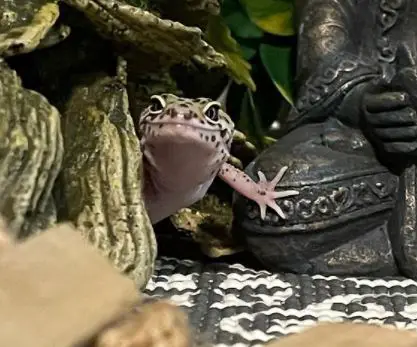How often should you clean your leopard gecko tank?
Leopard geckos are one of the most popular pet reptiles and their popularity is only growing. They’re fairly easy to take care of, but one major question that many new owners have is: How often should I clean my leopard gecko tank?
This article will answer this question in detail and provide tips for maintaining a healthy environment for your leopard gecko.
It’s important to ensure that you properly maintain their habitat so they can thrive in it.
Related Posts:
- Top 7 Best Leopard Gecko Starter Kits for Easy Setup
- What Tank Size Does a Leopard Gecko Need?
- How Often Should You Mist a Leopard Gecko Tank?
- How Deep Should Leopard Gecko Substrate Be?
- Why Is My Leopard Gecko Hiding and Not Eating?
How Often Should You Clean Your Leopard Gecko Tank?
How often should you clean your leopard gecko tank?
You should clean your leopard gecko tank once a day to keep it from getting too dirty. Once every 2 months, you need to take everything out of the cage and throw away the substrate.
Scrub and disinfect the cage and all the items in it to get rid of bacteria.
How to Clean Leopard Gecko Tank?
Leopard gecko is a species of lizard that has an amazing look and unique appearance.
It has become a popular pet in recent years.
Leopard geckos are lizards that have the certain instinct of self-cleaning their body by licking off microorganisms or dirt that are stuck on their skin whenever they want to keep themselves clean, healthy, and happy.
It doesn’t mean you don’t need to help your leopard gecko clean his tank or place but it’s just for your information so that the next time you see some dirt clung onto his skin, you know he can lick it off himself.
It won’t hurt him if you notice there is still some excess dirt/dust outside the tank, so better clean it up.
Many people ask me why they see their leopard gecko always stick itself on top of tanks or plastic containers.
That’s what they usually do to get rid of the dirt that clung onto them after eating some insects.
They also don’t need any special accessories for this matter, so you can just keep it simple by providing him with a good tank with proper lighting and temperature.
After feeding your leopard gecko, let him clean himself on top of tanks but only if the lid doesn’t have any holes on it because he might accidentally fall down.
It’s very important to provide him with a safe place to stay in his cage/tank more than anything else. We’re talking about geckos, which are very fragile and can easily fall like a dead leaf.
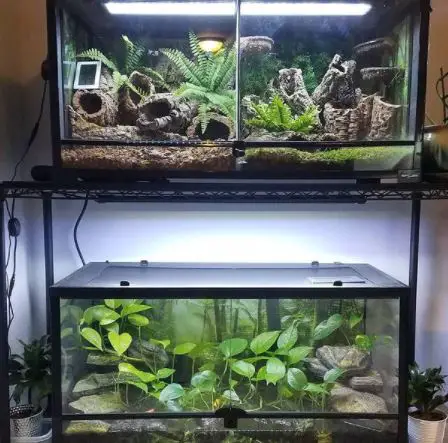
Back to the question: How do you clean a leopard gecko tank?
The cleaning process is easy as long as we know how we should take care of them.
They may look dirty sometimes, but with proper knowledge on how to keep them healthy, it is actually not that hard to maintain if you treat them well and follow certain steps:
- Remove all items such as rocks, branches, or any decorations from the tanks. Also, remove your gecko from his cage/tank for safety reasons so he won’t get hurt during the cleaning process.
- Fill the bottle cap with warm water and drop some dish soap inside it and shake it until it foams up.
- Wipe the inside walls of tanks or plastic containers with a paper towel or old t-shirt, which you can use for cleaning purposes.
- Make sure all dirt clung onto walls are gone before moving to the next steps. This process will also help you in finding any cracks on your tank so better check it out before putting gecko back into it.
- If you think your household sponge is too big to clean the tiny spaces, try to find a small one suitable for this matter because that’s what I did when I was still a newbie keeping them and found that my fingers were not flexible enough until I bought a small household sponge, which can easily reach any areas where other sponges fail to do so.
- Let your tanks dry up for at least 1 day before putting the gecko back in.
- For better results, you can use vinegar or peroxide solution to make your tanks clean and good-looking again, but It is recommended to do this step ONLY if you need to because cleaning process with warm water is enough for us.
Practice the steps above regularly/periodically, especially when it’s time to feed your leopard gecko. Don’t wait until dirt becomes too visible that you have no choice but start making your own way on how to clean the leopard gecko tank.
You have no idea how many times I saw people complaining about their geckos getting sick after they fail to clean their tanks regularly, so please follow certain steps mentioned here in order to keep your beloved gecko safe.
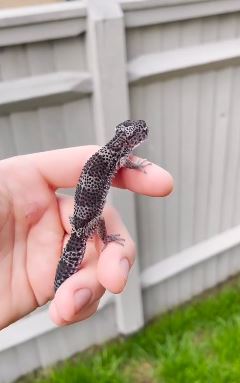
Can You Use Vinegar to Clean a Leopard Gecko Tank?
You can use vinegar to clean a leopard gecko tank.
To clean the cage, mix a little vinegar and water. Do this once every four months or so. Vinegar is not as strong as bleach but it will help get rid of any bacteria inside the cage without hurting your gecko.
Vinegar could probably be used, but I wouldn’t recommend using it regularly. We use white vinegar in our iguana’s misting bottle to help prevent the build-up of calcium in the glass.
It also works great for cleaning the cage, but every so often, we’ll use a bleach solution or even just very hot water to clean the glass because bleach will kill just about everything you have growing in your lizard tank whereas white vinegar will not.
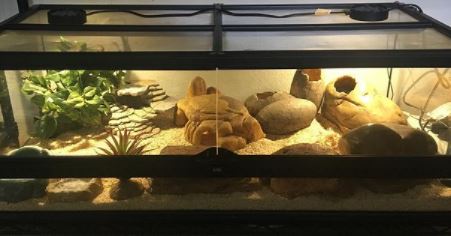
What Do You Need to Clean Leopard Gecko Poop?
You will need some paper towels, newspaper, clothes, gloves, and either a scoop or spoons.
Gloves are optional, but I highly recommend you get them because they prevent any bacteria from festering on your hands.
Bacteria can spread via contact with the skin, so gloves are important if you don’t want to get ill after cleaning out your beloved pet’s cage.
How to Clean Leopard Gecko Poop?
First off, get all your materials together, then get into position.
You might not want to stand there in full gardening gear holding a shovel when someone walks in!
First, make sure that the room is well lit, nice, and warm (around 80-90°F) and that the tank has been covered with a dark cloth to make it easier for you to see inside.
Now take your scoop or spoon and start removing the mess from the enclosure.
Depending on how many geckos are in there determines how long this section takes.
You might not believe me but cleaning up poop is easy. I find it therapeutic even! Once all of it has been scooped out, dispose of it in an appropriate place (not down the toilet).
Second, wipe over all surfaces in the cage with your chosen scouring pad or towel.
Do this until they are absolutely spotless, then continue onto stage three.
Now, spray down everything in sight with water because you want to be 100% sure there is no mess left before you start to put the tank back together.
Last, reassemble your gecko’s enclosure and replace all of the substrates.
Remember to keep it clean, so periodically change out the substrate or wash it thoroughly to avoid a build-up of bacteria if possible!
And that’s how easy cleaning leopard gecko poop is!
Give it a go yourself and let me know down below in the comments section how you found it.
How to Clean a Leopard Gecko Mat?
Mat cleaning is a very important part of health care for leopard geckos.
This will ensure that the leopard gecko’s environment does not become dirty, which can cause your lizard to get sick or die.
You should clean their mat once every two months.
First, you must remove the mat from inside your leopard gecko’s enclosure and place it in a small plastic tub or bin.
Next, you need to place about 1/4 cup of bleach into your plastic tub with your mat to soak for 30 minutes.
Make sure that the entire mat has been covered by bleach water. If there are still spots left uncovered, pour additional bleach over them until all areas are soaked well.
After 30 minutes, take your mat and scrub each area that contains feces or urate with a soft brush.
Let the mat sit for about an hour before fully rinsing out all bleach leftover.
There is no need to wash it more than once, as this will remove too many good bacteria from your mat. After letting it dry in your leopard gecko’s enclosure, you can place it back inside of his home.
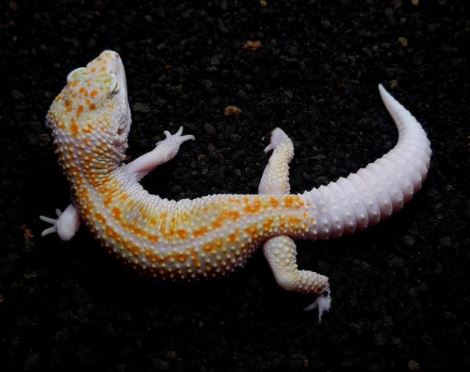
Conclusion
How often should you clean your leopard gecko tank? The answer is once a day!
The best way to keep your leopard gecko tank clean is by following these easy steps.
Remember, giving your pet an environment where they can thrive and live healthy lives will help you develop a stronger bond with them.
Key points to remember when considering how often you should be cleaning your leopard geckos tank:
Maintaining a clean and healthy habitat for your leopard gecko is essential to ensure their well-being. Here are some guidelines on how often to clean your leopard gecko’s tank:
1. Daily Spot Cleaning:
- Remove feces and uneaten food daily to maintain a sanitary environment. Replace water as needed.
2. Weekly Substrate Change:
- Replace a portion of the substrate or clean the entire substrate every week. The frequency depends on the type of substrate used. For paper towels or reptile carpet, replace them as needed.
3. Monthly Full Clean:
- Perform a comprehensive tank cleaning at least once a month. This includes removing your gecko, cleaning all items in the enclosure, and disinfecting surfaces.
4. Remove and Clean Decor:
- Remove and clean or disinfect decorations, hides, and other tank furnishings during monthly cleanings.
5. Sanitize Water Dish:
- Thoroughly clean and sanitize the water dish during monthly cleanings. This helps prevent the growth of harmful bacteria.
6. Check for Shedding:
- If your leopard gecko is shedding, provide a moist hide and mist the enclosure as needed to aid the shedding process.
7. Address Soiled Hides:
- Check the warm and cool hides for feces or other contaminants, and clean them promptly.
8. Evaluate Health:
- During monthly cleanings, closely observe your gecko for any signs of health issues or concerns, such as stuck shed or changes in behavior.
9. Deep Clean Annually:
- Perform a more thorough deep clean of the entire tank, including substrate replacement, decor disinfection, and enclosure sterilization, once a year.
10. UVB Light Maintenance: – If you use UVB lighting, check and replace the bulbs as recommended by the manufacturer. Proper UVB exposure is crucial for your gecko’s health.
11. Check and Secure Tank Locks: – Ensure all locks and closures on the tank are functioning properly to prevent accidental escapes.
12. Keep Handling to a Minimum: – Avoid excessive handling of your gecko during cleaning to minimize stress. If handling is necessary, be gentle and brief.
13. Use Safe Cleaning Products: – When disinfecting the tank or items within it, use reptile-safe cleaning products or a mild, diluted bleach solution (properly rinsed).
14. Maintain Optimal Temperatures: – Ensure the enclosure maintains the appropriate temperature gradients for your leopard gecko, as this aids digestion and overall health.
15. Proper Nutrition: – Maintain a healthy diet for your gecko, providing the necessary vitamins and supplements for their well-being.
16. Keep Stress Low: – Minimize environmental stressors during and after cleaning to help your leopard gecko adapt to changes in their environment.
17. Veterinary Care: – Schedule regular check-ups with a reptile veterinarian to ensure your gecko’s health and address any medical concerns.
In summary, a clean and well-maintained leopard gecko tank is crucial for your pet’s health and happiness. Daily spot cleaning, weekly substrate changes, and monthly comprehensive cleanings are fundamental maintenance tasks. By adhering to these guidelines and providing the appropriate care, you’ll create a safe and comfortable habitat for your leopard gecko.

